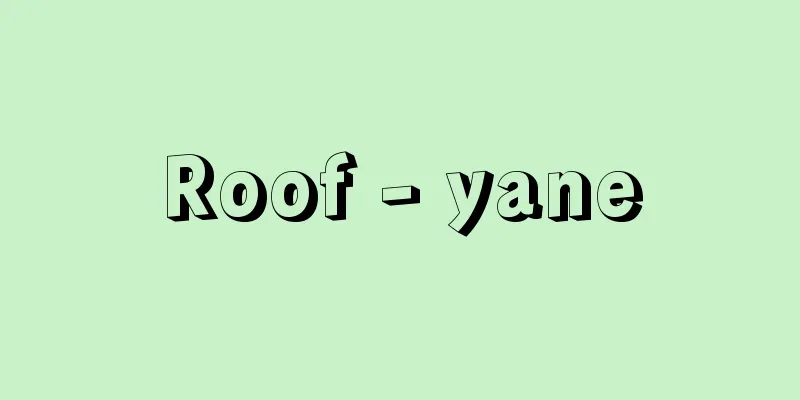Imperial edict - Shochoku

|
A general term for documents issued by the Emperor in his official capacity, including imperial edicts, imperial letters, and imperial rescripts. Since ancient times, following the Chinese example, imperial edicts were issued for extraordinary important matters, and imperial orders for ordinary minor matters, but the distinction was not strict. The official ordinances of the Taiho Code (701) were the first to stipulate the format and issuance procedures for imperial edicts and imperial decrees. There were five formats for imperial edicts, and the original was prepared by the Ministry of Central Affairs, signed by the Prime Minister, and the Emperor wrote the date and the character "OK" (approval) himself. These were called Goenichi (day of drawing) and Goeka (okay). Imperial edicts read to the royal subjects were written in the national style and were called Senmyo (decrees). Imperial decrees were issued through simpler procedures than imperial edicts. From the Heian period onwards, simplified imperial edicts and rinji (imperial orders) were frequently issued. From the Kamakura period onwards, nyobohosho (messages from chamberlains), which were similar to internal imperial orders, were often used. After the Meiji Restoration, imperial edicts were frequently issued in response to important events, and the emperor used the first person pronoun "chin" (my) and a unique literary style that used many Chinese words. In 1907 (Meiji 40), an official ordinance was enacted, stipulating the distinction and format of imperial edicts. Imperial edicts are imperial orders concerning important matters of the Imperial Household and the exercise of supreme power that are presented to the people. They are signed by the emperor and affixed with the Imperial Seal, and countersigned by the Minister of the Imperial Household, the Prime Minister, Ministers of State, etc. Imperial edicts are written imperial orders that are not shown to the people. Jo-yu (a message from the emperor) refers to an imperial order that is placed before the articles when a law or imperial ordinance is promulgated. Imperial Rescripts are the words of the Emperor, and written versions of these are also called Imperial Rescripts. Other examples include Imperial Rescripts, Imperial Decrees, sovereign letters to foreign countries, and personal letters. With the coming into force of the Constitution of Japan in 1947 (Showa 22), official ordinances were abolished. Currently, Imperial Rescripts are issued regarding the Emperor's acts in matters of state, and Imperial Rescripts are issued to appoint the Prime Minister and the Chief Justice of the Supreme Court. In 1953, Imperial Rescripts were changed to being called "Okotoba". In "Okotoba", the Emperor uses "watakushi" as his first-person pronoun, and normal writing style is used. [Shigeyoshi Murakami] Source: Shogakukan Encyclopedia Nipponica About Encyclopedia Nipponica Information | Legend |
|
天皇が公の資格で発する文書の総称で、詔書、勅書、勅語などをいう。古代以来、中国に倣って、臨時の大事には詔、尋常の小事には勅を発するとされたが、その区別は厳密ではない。大宝律令(たいほうりつりょう)(701)の公式令(くしきりょう)で、初めて詔書と勅旨などの書式と発給手続が規定された。詔書の書式は5通りあって、中務(なかつかさ)省で原案を作成し、太政(だいじょう)大臣らが署名し、天皇は日付と裁可を意味する「可」を自記した。これを御画日(ごえにち)、御画可(ごえか)という。王臣に読み聞かせる詔書は国文体で、宣命(せんみょう)と称した。勅旨は、詔書よりも簡略な手続で発給された。平安時代からは、簡略な形式の宣旨、綸旨(りんじ)が盛んに発せられた。鎌倉時代以降は、内勅に類する女房奉書(にょうぼうほうしょ)が多用された。明治維新後は、事に臨んで詔勅が盛んに出されるようになり、天皇の一人称を「朕(ちん)」とし、漢語の多い独自の文語体が用いられた。1907年(明治40)公式令が制定され、詔勅の区別と形式が規定された。詔書は、皇室の大事と大権の施行に関する勅旨を国民に示すもので、天皇が署名して御璽(ぎょじ)を捺(お)し、宮内大臣、内閣総理大臣、国務大臣等が副署する。勅書は、文書による勅旨で、国民には示されない。上諭は、法律、勅令の公布に際して条文の前に付する勅旨をいう。勅語は天皇のことばで、それを文書にした勅語書も勅語という。ほかに、勅諭、御沙汰(さた)、外国に対する国書、親書がある。1947年(昭和22)日本国憲法の施行に伴い、公式令は廃止された。現在は、天皇の国事行為に関して詔書が発せられ、内閣総理大臣、最高裁判所長官の任命には勅書が出される。勅語は、53年から「お言葉」と称することに改められた。「お言葉」では、天皇の一人称は「わたくし」で、普通の文体が用いられる。 [村上重良] 出典 小学館 日本大百科全書(ニッポニカ)日本大百科全書(ニッポニカ)について 情報 | 凡例 |
Recommend
Azo Lake Pigments - Azo Lake Pigments
...When organic pigments are classified based on ...
Hutchinson, GE (English spelling)
...For the birds and animals they mainly dealt wi...
La Parisienne (English spelling)
…But this work was also criticized as being too g...
Exanthem subitum (Roseola infantum)
What kind of infection is it? This is an acute vi...
Veteran - Zaigōgunjin
A system established to maintain reserve forces i...
Zizi Jeanmaire (English)
…[Tsutomu Sakurai]. … *Some of the terms that men...
EXAFS - EXAFS
...X-ray fluorescence analysis is the same analyt...
Ganga Yamuna Doab - Ganga Yamuna Doab
…In the Indian subcontinent, “do” means “two” in ...
Tokubire (special fin) - Tokubire
A general term for marine fish belonging to the fa...
Muslim - Islam Kyoto
…the term used in Europe, especially in the Middl...
Modernization Theory
… However, at the same time, American social scie...
Hantaro Nagaoka
Physicist. The only son of Nagaoka Jisaburo (1839...
Weimar Constitution - Weimar Constitution
The Constitution of the Weimar Republic. The Germa...
Hijiki - Hijiki
A brown alga, a member of the Sargassaceae family...
Goldbach conjecture
C. Goldbach stated the following conjecture in a l...






![Vermont [State] - Vermont](/upload/images/67cc8e337d328.webp)


